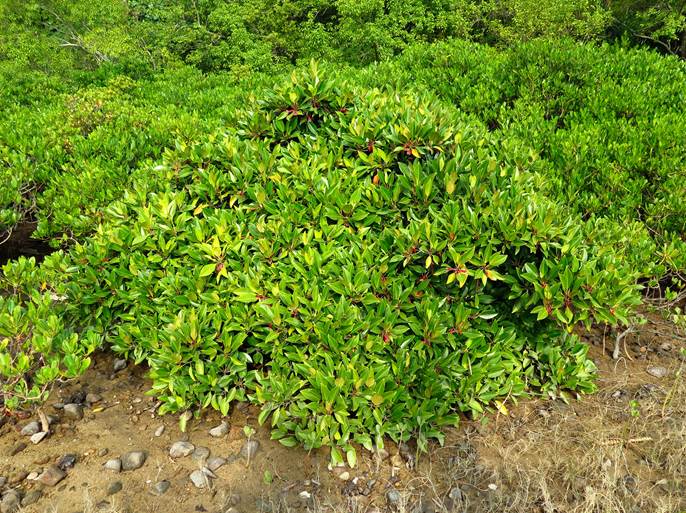Mangrove
Mangroves refer to a distinctive habitat which is usually found in upper intertidal regions of estuaries in sheltered tropical and subtropical shores, receiving inputs from regular tidal flushing and from freshwater streams and rivers.

Mangrove plants can be classified into two types: true mangroves and mangrove associates. True mangroves have developed at least one or more specialised physiological or morphological adaptations in order to survive in such stressful environment. Mangrove associates is a group of plants growing between mangrove plants and the land but seldom immersed by normal tides.
The habitats of mangrove are characterised by:
| - | High temperature |
| - | Fluctuating salinity |
| - | Alternating aerobic and anaerobic conditions |
| - | Periodic wet and dry environments |
| - | Unstable and soft substratum |
The Ting Kok mangrove in Tolo Harbour, a hard bottom mangal in more oceanic waters, has an area of 8.77 hectares. This mangrove is the fourth largest among 44 mangal stands in Hong Kong and is also the largest one along the rest of Hong Kong’s coastline, supporting high biodiversity of flora and fauna. Six out of eight true mangrove plant species can be found in Ting Kok. Mangrove associates such as Clerodendrum inerme and Talipariti tiliaceum are very common there.
Other plant species such as Pandanus tectorius, Suaeda australis, and Limonium sinense can also be found in this stand.
The mangrove ecosystem is one of the most important ecological habitats in Hong Kong. The detritus, which is mainly fallen leaves, provides food for numerous marine lives. The high productivity of mangrove wetlands offers shelters, breeding and nursery grounds for marine fauna such as juvenile fish, crabs, shrimps, mollusks, seahorses and starfish, etc.
True Mangrove

Kandelia obovata |

Kandelia obovata - Flowers |
|

Kandelia obovata - Fruit |

Bruguiera gymnorrhiza |
|

Bruguiera gymnorrhiza - Flowers |

Bruguiera gymnorrhiza - Fruits |
|

Excoecaria agallocha |

Excoecaria agallocha - Flowers |
|

Excoecaria agallocha - Fruits |

Lumnitzera racemosa |
|

Lumnitzera racemosa - Flowers & Fruits |

Aegiceras corniculatum |
|

Aegiceras corniculatum - Flowers |

Aegiceras corniculatum - Fruits |
|

Avicennia marina |

Avicennia marina - Fruits |
Mangrove Associates
 Talipariti tiliaceum - Flower |

Talipariti tiliaceum - Leaves |
|

Talipariti tiliaceum - Fruits |

Clerodendrum inerme |
Other Plants

Pandanus tectorius |

Suaeda australis |

Limonium sinense |
||
 Poaceae Plant |

Sesuvium portulacastrum |

Colpomenia sinuosa |
||

Ulva intestinalis |
| Back to Top |

Infauna, bivalves, worms and other burrowing crabs are commonly found in mangrove habitats in Ting Kok.
In addition, crabs, worms and countless small invertebrates on mudflat attract a number of bird species such as Little Egret (Egretta garzetta) and Black Kite (Milvus migrans) foraging on the mudflat. Birdies with the natural environment as a background, they constitute a wonderful scene in Ting Kok.

Egretta garzetta |

Ardea alba |
|

Milvus migrans |

Copsychus saularis |